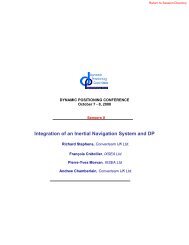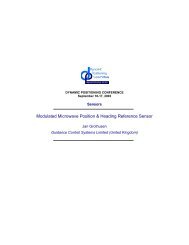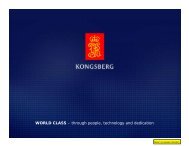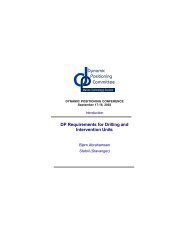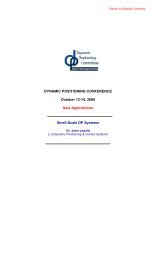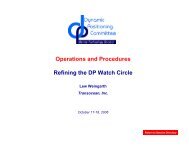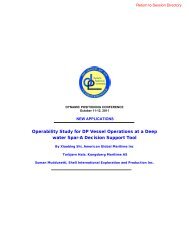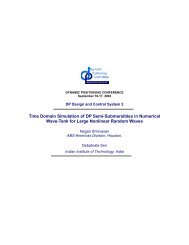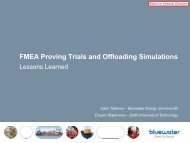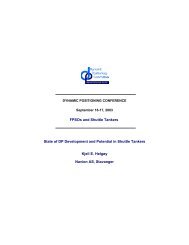A New Concept for Fuel Tight DP Control - Dynamic Positioning ...
A New Concept for Fuel Tight DP Control - Dynamic Positioning ...
A New Concept for Fuel Tight DP Control - Dynamic Positioning ...
Create successful ePaper yourself
Turn your PDF publications into a flip-book with our unique Google optimized e-Paper software.
Author’s Name Name of the Paper SessionP<strong>Dynamic</strong><strong>Positioning</strong>CommitteeMarine Technology SocietyDYNAMIC POSITIONING CONFERENCESeptember 18-19, 2001POWER PLANT SESSIONA <strong>New</strong> <strong>Concept</strong> <strong>for</strong> <strong>Fuel</strong> <strong>Tight</strong> <strong>DP</strong> <strong>Control</strong>Ole Gunnar Hvamb, Kongsberg Simrad
Return to Session Directory >Ole Gunnar Hvamb Power Plant Session A <strong>New</strong> <strong>Concept</strong> <strong>for</strong> <strong>Fuel</strong> <strong>Tight</strong> <strong>DP</strong> <strong>Control</strong>IntroductionCompared to existing <strong>DP</strong> systems, the new concept named Green<strong>DP</strong> ® is designed with focuson reducing fuel consumption. <strong>DP</strong>s have traditionally been designed to obtain a “bulls eye”station keeping per<strong>for</strong>mance in a changing environment. The new design emphasizes keeping thevessel within its operational boundaries. In deep-water operations, e.g. drilling, quite largeoperational areas may be permissible.This new controller design consists of two main parts:− Environment Compensator− Predictive <strong>Control</strong>lerThe Environment Compensator is designed to give a slowly varying thruster demandcompensating <strong>for</strong> the average environmental <strong>for</strong>ces. <strong>Concept</strong>ually the thrust generated is similarto the traditional <strong>DP</strong>-controller, but with much slower and smoother response. This demand willmaintain the wanted position under average conditions, but reacts very leisurely to a changingenvironment. Thus, keeping the power consumption more stable and reduce the thruster usage.Model Predictive<strong>Control</strong>ler DemandEnvironmentalCompensator DemandThe two components: Environment Compensator and Model Predictive <strong>Control</strong>lerThe Predictive <strong>Control</strong>ler brings our experience of motion prediction one step further by using a<strong>for</strong>ecast of the vessel movement as an input <strong>for</strong> the controller. The Predictive <strong>Control</strong>ler demandis taking action during more hefty changes in the external <strong>for</strong>ces. The prediction is considered inconjunction with pre-set position boundaries. When the prediction indicates that the boundarieswill be broken the controller reacts swiftly; assuring that the vessel will stay within theoperational area.Forcasted <strong>Fuel</strong> ReductionsThe new control strategy has been verified through detailed dynamic simulations representingweather conditions from the North Sea (typical conditions <strong>for</strong> a one-year operation). The fuelreduction is found to be approximately 20% over the year. Similarly, CO 2 , NO x and other gassesemitted to the atmosphere are reduced with about the same amount.<strong>Dynamic</strong> <strong>Positioning</strong> Conference September 18-19, 2001 Page 2
Return to Session Directory >Ole Gunnar Hvamb Power Plant Session A <strong>New</strong> <strong>Concept</strong> <strong>for</strong> <strong>Fuel</strong> <strong>Tight</strong> <strong>DP</strong> <strong>Control</strong>In addition to fuel reduction, the variation of the power consumption is reduced tremendously.The standard deviation in power variations has shown to drop by more than 50%, and in badweather conditions up to as much as 80%. This will have several effects:−−−−Reduced wear and tearMore optimal operation of dieselsLower maintenance costIncreased operational reliabilityAn example is shown in the next two figures. The upper graph shows positioning in Northdirection (m) <strong>for</strong> Normal <strong>DP</strong> and Green<strong>DP</strong> ® as function of time (sec) <strong>for</strong> exactly the samewind, wave and current (typical <strong>for</strong> North Sea bad weather winter conditions). The graph belowshows the corresponding electric power consumption (kW) of the thrusters. Since the powervariations are much smaller the number of running generators may be reduced. Hence the dieselengines may operate more optimal and significant fuel saving may be obtained.<strong>Positioning</strong> (m)200-20Power consumption (kW)0 1000 2000 3000 4000 5000 6000 700010000Red curve: Normal <strong>DP</strong>Green curve: Green<strong>DP</strong> ®90008000700060005000400030002000100000 1000 2000 3000 4000 5000 6000 7000Time [s]Red curve: Normal <strong>DP</strong>Green curve: Green<strong>DP</strong> ®<strong>Dynamic</strong> <strong>Positioning</strong> Conference September 18-19, 2001 Page 3
Return to Session Directory >Ole Gunnar Hvamb Power Plant Session A <strong>New</strong> <strong>Concept</strong> <strong>for</strong> <strong>Fuel</strong> <strong>Tight</strong> <strong>DP</strong> <strong>Control</strong>How is Green<strong>DP</strong> ® Working?The concept utilizes new controltechnology with advanced modeling andreal time optimization techniques to getbest possible vessel per<strong>for</strong>mance withinuser defined operational constraintsVessel PositionEnvironmental load−−Operational area, elliptic or rectangularin two levels as shown in the figure tothe right,− The full Operational Area and− The Working AreaMaximum dynamic thrust to be usedOperational AreaWorking AreaWanted PositionThe vessel is free to move about in the Working Area. The user may influence the controlthrough his setting of operational constraints. By limiting the amount of dynamic thrust to beapplied, early actions will be taken preventing overstepping the boundaries.<strong>Control</strong> actions are optimized according to predicted future vessel motion as shown in the threecases below, not only its present movements as normally done in <strong>DP</strong> systems. The arrowsindicate predicted trajectories and the dot the present position of the vessel.Vessel predicted to stay inside Working Area− Compensate the average environmental loadonly− No additional dynamic thrust neededVessel predicted to violated Working Area− Compensate the average environmental load− Find additional dynamic thrust reducing thepredicted overshoot as a best compromisebetween overshoot and thrust usage− “Cost tags” are associated with thruster useand overshootVessel predicted to violated Operational Area− Compensate the average environmental load− Find additional dynamic thrust bringing the<strong>for</strong>ecasted vessel position inside theOperational Area and as close to theWorking Area as possible as a bestcompromise between overshoot and thrustusage. A maximum permissible dynamicthrust is used if necessary− “Cost tags” are associated with thruster useand overshoot<strong>Dynamic</strong> <strong>Positioning</strong> Conference September 18-19, 2001 Page 4
Return to Session Directory >Ole Gunnar Hvamb Power Plant Session A <strong>New</strong> <strong>Concept</strong> <strong>for</strong> <strong>Fuel</strong> <strong>Tight</strong> <strong>DP</strong> <strong>Control</strong><strong>Control</strong> MethodologyGreen<strong>DP</strong> ® is a result of a large R&D project carried out in Kongsberg Simrad since 1997 as partof the Norwegian Research Counsel’s program “KLIMATEK” (climate technology - aiming atreducing outlet of climate gasses). The program is a co-operation between Norwegiangovernment, Oil Companies and the offshore equipment industry. Kongsberg Simrad has workedtogether with SINTEF (The Foundation <strong>for</strong> Scientific and Industrial Research at the NorwegianInstitute of Technology) in developing this new control methodology. Shell, NorwegianPetroleum Directorate and Saipem have also been engaged.The control consists of three major components:−−−Environment Compensator,Model Predictive <strong>Control</strong>lerPosition PredictorWhile the Environment Compensator is based on the mature theory of Optimal <strong>Control</strong> used in<strong>DP</strong> systems <strong>for</strong> a long period of time, the Model Predictive <strong>Control</strong>ler is based on a moderntheory called Non-linear Model Predictive <strong>Control</strong> (NMPC). As the name indicates the NMPChas a predictive behavior. By continuously solving an accurate non-linear dynamic mathematicalmodel of the vessel, the future vessel behavior is <strong>for</strong>ecasted. This is the task of the PositionPredictor. Since the mathematical model of a <strong>DP</strong> vessel is non-linear, non-linear theory must beapplied.Earlier Model Predictive <strong>Control</strong>ler (MPC) has been applied to industrial plants. The non-linearversion represents a further step in the technological development.WindWanted positionThrustPositionreferencesEnvironmentalCompensatorModel Predictive<strong>Control</strong>ler &Position PredictorKalman FilterThe Green<strong>DP</strong> ® <strong>Control</strong>ler<strong>Dynamic</strong> <strong>Positioning</strong> Conference September 18-19, 2001 Page 5
Return to Session Directory >Ole Gunnar Hvamb Power Plant Session A <strong>New</strong> <strong>Concept</strong> <strong>for</strong> <strong>Fuel</strong> <strong>Tight</strong> <strong>DP</strong> <strong>Control</strong>The Environment Compensator is designed to give a slowly varying thruster demandcompensating the average environmental <strong>for</strong>ces. <strong>Concept</strong>ually the demand generated is similar tothe traditional <strong>DP</strong>-controller, but with much slower and smoother response. The input to theEnvironmental Compensator is the measured wind and estimated current calculated by the <strong>DP</strong>Kalman Filter, and a <strong>for</strong>ecast of how the vessel is going to move, the Wanted Position orReference Trajectory.The trajectory represents the desired behavior of the vessel when doing a change of position orfollowing a desired track path. The unknown <strong>for</strong>ces from waves and currents are all parts of theestimated current velocity.Due to its nature the system will not instantaneously react to a wind gust unless the PositionPredictor detects that actions must be taken immediately. Hence unnecessary sudden thrusting isavoided.The Model Predictive <strong>Control</strong> algorithm is much more complex and time-consuming incomputing than the traditional controller designs generally used <strong>for</strong> <strong>DP</strong>.The NMPC algorithm has three computational demanding steps:−−−Prediction of movement from the non-linear vessel modelFinding the step response mappingDefining and solving the optimization task of calculating the “best possible” thrust to beapplied.In order to handle these increased computational requirements, Kongsberg Simrad has developeda new and more powerful control computer, the SBC500.The Position Prediction is made by taking advantage of the mathematical model of the vesselused in the Kalman filter of the <strong>DP</strong>. The <strong>for</strong>ecasted position and heading are found step by step<strong>for</strong> the whole prediction horizon. This is used as a basis <strong>for</strong> the step response mapping thatdescribes how the predicted trajectory will change with changing thruster demands.The optimization is <strong>for</strong>mulated as a quadratic programming problem with linear inequalityconstraints associated with the physical thruster limitations. One of the great benefits of theNMPC is the way of incorporating constraints on the predicted-, measured-, and estimatedvariables. The predicted position trajectory is constrained by inserting position boundaries givenby the physics of the marine operation itself. Additionally restrictions may be put on the vesselvelocity or rate of change in thrust demand.There are two different constraints in the optimizing algorithm:−−“soft limits” (which are weighted quadratic in the optimization) typically the Working Areaboundary“hard limits” (weighted linearly) typically the Operational Area boundary<strong>Dynamic</strong> <strong>Positioning</strong> Conference September 18-19, 2001 Page 6
Return to Session Directory >Ole Gunnar Hvamb Power Plant Session A <strong>New</strong> <strong>Concept</strong> <strong>for</strong> <strong>Fuel</strong> <strong>Tight</strong> <strong>DP</strong> <strong>Control</strong>Operational limits (Working Area - “soft” inner boundary and Operational Area - “hard” outer limit)These constraints have a very different behavior when optimizing. A quadratic weightedconstraint is adding smooth demand when predicting overstep, while a linear constraint willallocate as much demand as necessary (or allowed) to keep the vessel within the constraint.In the traditional <strong>DP</strong> controller there are no outer operational limits. This controller is designed tokeep a “bulls eye” per<strong>for</strong>mance and give a proportional demand like a rubber band being tied tothe wanted position and the center of the vessel. There is also a damping keeping the velocity asclose to zero as possible.With the new controller the demand is, as mentioned above, split in two parts: the demand fromthe Environmental Compensator and the demand from the Model Predictive <strong>Control</strong>ler.The “cost function” in the NMPC optimization is configured to minimize only the variables thatovershoot the constraints. In contrast to the continuos restoring <strong>for</strong>ce demand generated betweenthe vessel and its wanted position in the traditional controller, a repulsive <strong>for</strong>ce is generatedbetween the vessel and its boundaries by the NMPC controller.Thus, in the new controller design, the Environment Compensator, generates a leisurely attractive<strong>for</strong>ce towards the wanted position whilst the Model Predictive <strong>Control</strong>ler adds a more swiftdemand repulsive to the predicted overshoot of the limits.The Environmental Compensator will always provide a thrust demand making the vesselmaintain its position in average and secures zero steady state position deviation. But since itreacts very leisurely larger deviation from the wanted position may be experienced when theexternal <strong>for</strong>ces change.During normal operation, without great changes in the external environment, the demandsallocated to the thrusters come exclusively from the Environmental Compensator. Only duringmore dramatically changing external <strong>for</strong>ces the demand from the Model Predictive <strong>Control</strong>ler isadded as a result of predicted overstepping pre-set limits <strong>for</strong> the Working- or Operational Area.Since the Environmental Compensator is designed to give a smooth and slowly varying demand,the change in power usage is also much more relaxed. There are less peaks of high consumptionand the power level is very steady. The average <strong>for</strong>ce needed to stay on positioned is the same as<strong>for</strong> the traditional <strong>DP</strong> since the new controller design does not change the physics.There<strong>for</strong>e, the power level needed over time is lower and the number of generators running canbe kept lower. Since the rate of change in power consumption also is significantly reduced,generators do not need to pick up load as quickly.<strong>Dynamic</strong> <strong>Positioning</strong> Conference September 18-19, 2001 Page 7
Return to Session Directory >Ole Gunnar Hvamb Power Plant Session A <strong>New</strong> <strong>Concept</strong> <strong>for</strong> <strong>Fuel</strong> <strong>Tight</strong> <strong>DP</strong> <strong>Control</strong>OptimizationThe operational constraints are the clue to the optimization, and can be set to cover stationkeeping, position moves as well as track operations.The objective of the optimization is to find the smallest thrust vector which will bring thepredicted vessel trajectory inside (or as close to the Working Area as possible) taking into accountthe “cost” of thruster usage and overstepping the different boundaries:− Thrust (fixed “high” quadratic cost)− Working Area (“moderate” quadratic cost outside boundary)− Operational Area (“very high” linear cost outside boundary)PredictedTrajectoryOperationalAreaWorkingAreaIn order to solve this optimization, the Position Predictor is used to find the anticipated futurevessel motion, the Predicted Trajectory within our prediction horizon assuming that only thethrust provided by the Environmental Compensator is applied. See figure below.PositionPredictedTrajectoryOperationalAreaWorkingAreaTimeIn the figure the Predicted Trajectory oversteps both boundaries. The optimizer will then find theoptimal dynamic thrust keeping the new Predicted Trajectory as close to the Working Area aspossible. Note that the new Predicted Trajectory will always overshoot the Working Areaboundary because there is a “cost” associated with the use of thrusters and no “cost” of stayinginside the Working Area boundary.On the other hand it is not necessarily true that the vessel really will move that far because theprediction horizon is long and the environment may improve during this period.The optimization is solved as a <strong>Dynamic</strong> Quadratic Programming problem where the stepresponse mapping gives the relationship between applied thrust and vessel trajectory. The result isindicated in the figure below.<strong>Dynamic</strong> <strong>Positioning</strong> Conference September 18-19, 2001 Page 8
Return to Session Directory >Ole Gunnar Hvamb Power Plant Session A <strong>New</strong> <strong>Concept</strong> <strong>for</strong> <strong>Fuel</strong> <strong>Tight</strong> <strong>DP</strong> <strong>Control</strong>PositionPredictedTrajectoryOperationalAreaWorkingAreaTimeAfter the optimization is completed, the sum of the thruster demands from the EnvironmentalCompensator and the Model Predictive <strong>Control</strong>ler are treated by the Thruster Allocation andapplied to the thrusters.The boundary conditions described in this example are typical <strong>for</strong> pure station keeping. Whendoing a position change the boundaries will be time dependent following a Nominal Trajectory,the most desirable vessel path. See figure below.PositionPredictedTrajectoryNominalTrajectoryWorkingAreaTimeOperationalAreaIn this case the Environmental Compensator also provides necessary acceleration anddeceleration <strong>for</strong>ces in order to <strong>for</strong> the vessel to follow the Nominal Trajectory.<strong>Dynamic</strong> <strong>Positioning</strong> Conference September 18-19, 2001 Page 9
Return to Session Directory >Ole Gunnar Hvamb Power Plant Session A <strong>New</strong> <strong>Concept</strong> <strong>for</strong> <strong>Fuel</strong> <strong>Tight</strong> <strong>DP</strong> <strong>Control</strong>Power Management SystemSince the new control concept requires very little dynamic thrust to keep the vessel on location,the dynamic thrust range can be restricted. Due to the controller’s predictive nature, it may startreacting early with a low dynamic thrust in stead of late with a quite bigger one.As a consequence the Power Management System may reserve a certain amount of power <strong>for</strong> thethrusters, and the <strong>DP</strong> will stay within this limit.The control system is based on the average needs to compensate the environment and the worstcase dynamic allowance, can calculate the amount of power to be reserved. This is illustrated inthe figure below.SpareDomesticDrillingThrusterAllocationPowerCalculationUsed byThrustersReserved<strong>for</strong>ThrustersPower accountThis also implies that automatic start and stop of generators per<strong>for</strong>med by the Power ManagementSystem can be made more intelligent, with significant smaller margins which will give anadditional effect on the fuel saving.This is illustrated in the next two figures showing power consumption and running capacity (kW)using normal <strong>DP</strong> and Green<strong>DP</strong> ® respectively as a function of time.1000090008000Capacity10000900080007000600070006000Capacity5000500040004000300020001000Usage300020001000Usage00 1000 2000 3000 4000 5000 6000 7000Normal <strong>DP</strong> Green<strong>DP</strong> ®00 1000 2000 3000 4000 5000 6000 7000Normally automatic stop is not used in <strong>DP</strong> operations. With a much smoother power demand,however, the main reasons <strong>for</strong> increased power needs are changes in the environment.Since the environment is generally not changing very quickly (except <strong>for</strong> e.g. loop current in theGolf of Mexico) and the system is estimating its own power demands to be reserved by the PowerManagement System automatic stop may be feasible.<strong>Dynamic</strong> <strong>Positioning</strong> Conference September 18-19, 2001 Page 10



